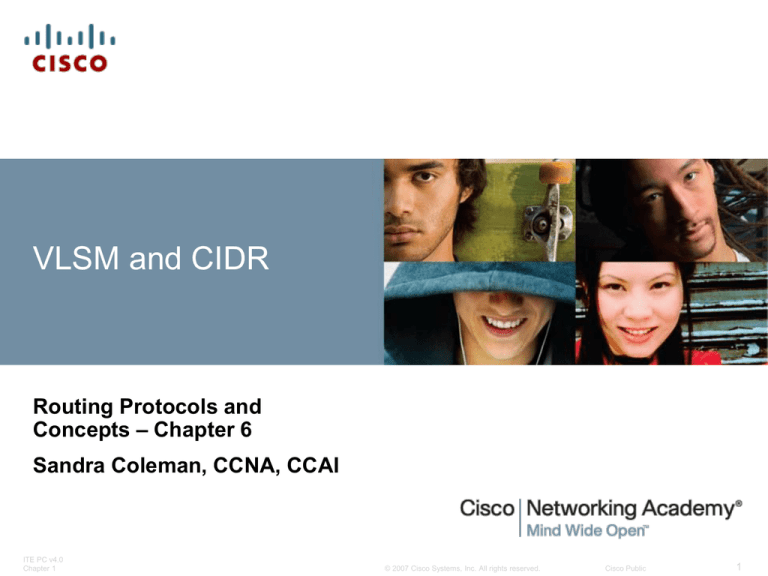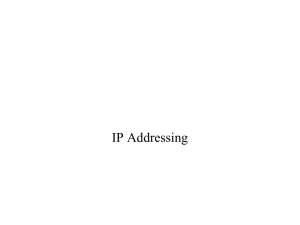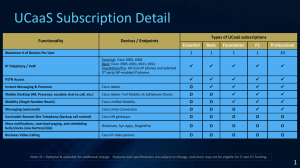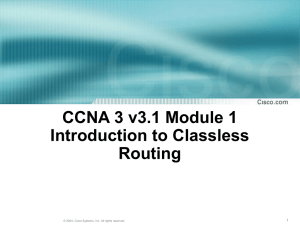
VLSM and CIDR
Routing Protocols and
Concepts – Chapter 6
Sandra Coleman, CCNA, CCAI
ITE PC v4.0
Chapter 1
© 2007 Cisco Systems, Inc. All rights reserved.
Cisco Public
1
Objectives
Compare and contrast classful and classless IP
addressing.
Review VLSM and explain the benefits of classless IP
addressing.
Describe the role of the Classless Inter-Domain
Routing (CIDR) standard in making efficient use of
scarce IPv4 addresses
Blue text is important!
ITE PC v4.0
Chapter 1
© 2007 Cisco Systems, Inc. All rights reserved.
Cisco Public
2
Introduction
Prior to 1981, IP addresses used only the first 8 bits to
specify the network portion of the address (known as
ARPANET)
In 1981, RFC 791 modified the IPv4 32-bit address to
allow for three different classes (A, B, C) – classful IP
addressing
IP address space was depleting rapidly
the Internet Engineering Task Force (IETF)
introduced Classless Inter-Domain Routing (CIDR)
–CIDR uses Variable Length Subnet Masking
(VLSM) to help conserve address space.
-VLSM is simply subnetting a subnet
ITE PC v4.0
Chapter 1
© 2007 Cisco Systems, Inc. All rights reserved.
Cisco Public
3
Classful and Classless IP Addressing
Classful IP addressing
As of January 2007, there are over 433 million hosts on
internet
Initiatives to conserve IPv4 address space include:
-VLSM & CIDR notation (1993, RFC 1519)
-Network Address Translation (1994, RFC 1631)
-Private Addressing (1996, RFC 1918)
ITE PC v4.0
Chapter 1
© 2007 Cisco Systems, Inc. All rights reserved.
Cisco Public
4
Classful and Classless IP Addressing
The High Order Bits
These are the leftmost bits in a 32 bit address
ITE PC v4.0
Chapter 1
© 2007 Cisco Systems, Inc. All rights reserved.
Cisco Public
5
Classful and Classless IP Addressing
Classes of IP addresses are identified by the decimal number of
the 1st octet
Class A address begin with a 0 bit
Range of class A addresses = 0.0.0.0 to 127.255.255.255
Class B address begin with a 1 bit and a 0 bit
Range of class B addresses = 128.0.0.0 to 191.255.255.255
Class C addresses begin with two 1 bits & a 0 bit
Range of class C addresses = 192.0.0.0 to 223.255.255.255.
ITE PC v4.0
Chapter 1
© 2007 Cisco Systems, Inc. All rights reserved.
Cisco Public
6
Classful and Classless IP Addressing
The IPv4 Classful Addressing Structure (RFC 790)
An IP address has 2 parts:
-The network portion
Found on the left side of an IP address
-The host portion
Found on the right side of an IP address
ITE PC v4.0
Chapter 1
© 2007 Cisco Systems, Inc. All rights reserved.
Cisco Public
7
Classful and Classless IP Addressing
ITE PC v4.0
Chapter 1
© 2007 Cisco Systems, Inc. All rights reserved.
Cisco Public
8
Classful and Classless IP Addressing
Purpose of a subnet mask
It is used to determine the network portion of an IP
address
ITE PC v4.0
Chapter 1
© 2007 Cisco Systems, Inc. All rights reserved.
Cisco Public
9
Classful Routing Updates – Know how to pick the subnet
mask for updates!
Recall that classful routing protocols (i.e. RIPv1) do not send
subnet masks in their routing updates . The reason is that the
Subnet mask is directly related to the network address
ITE PC v4.0
Chapter 1
© 2007 Cisco Systems, Inc. All rights reserved.
Cisco Public
10
Classful and Classless IP Addressing
Classless Inter-domain Routing (CIDR – RFC 1517)
Advantage of CIDR :
-More efficient use of IPv4 address
space
-Route summarization (prefix aggregation)
Requires subnet mask to be included in routing update
because address class is meaningless
Recall purpose of a subnet mask:
-To determine the network and host portion
of an IP address
ITE PC v4.0
Chapter 1
© 2007 Cisco Systems, Inc. All rights reserved.
Cisco Public
11
Classless IP Addressing
CIDR & Route Summarization
-Variable Length Subnet Masking (VLSM)
-Allows a subnet to be further sub-netted
according to individual needs
-Prefix Aggregation & Route Summarization &
supernetting – all mean the same thing!
-CIDR allows for routes to be summarized as a single
route thereby reducing the number of routing table entries.
ITE PC v4.0
Chapter 1
© 2007 Cisco Systems, Inc. All rights reserved.
Cisco Public
12
Classful and Classless IP Addressing
Classless Routing Protocol
Characteristics of classless routing protocols:
-Routing updates include the subnet mask
-Supports VLSM
Supports Route Summarization
ITE PC v4.0
Chapter 1
© 2007 Cisco Systems, Inc. All rights reserved.
Cisco Public
13
Classful and Classless IP Addressing
Classless Routing Protocol – OSPF, RIPv2, & EIGRP
Routing
Protocol
Routing
updates
Include
subnet
Mask
Supports Ability to send
VLSM Supernet routes
Classful
No
No
No
Classless
Yes
Yes
Yes
ITE PC v4.0
Chapter 1
© 2007 Cisco Systems, Inc. All rights reserved.
Cisco Public
14
VLSM
Classful routing
-only allows for one
subnet mask for all
networks
VLSM & classless routing
-This is the process
of subnetting a subnet
-More than one
subnet mask can be
used
-More efficient use of IP
addresses as compared
to classful IP
addressing
ITE PC v4.0
Chapter 1
© 2007 Cisco Systems, Inc. All rights reserved.
Cisco Public
15
What addresses could be assigned to the
LAN from each router, if the router’s
interface were given the 1st available
address?
ITE PC v4.0
Chapter 1
© 2007 Cisco Systems, Inc. All rights reserved.
Cisco Public
16
Calculating Subnet masks with VLSM
What subnet mask would you use for each subnet
given the following information:
Company XYZ has 3 departments..
Sales – 20 people
Administration – 5 people
Accounting – 50 people
Human Resources – 13 people
• You will have to do a similar problem on the test!
ITE PC v4.0
Chapter 1
© 2007 Cisco Systems, Inc. All rights reserved.
Cisco Public
17
Identifying addresses
You must be able to identify network and broadcast
addresses, given a diagram.
ITE PC v4.0
Chapter 1
© 2007 Cisco Systems, Inc. All rights reserved.
Cisco Public
18
VLSM
VLSM – the process of
subnetting a subnet to fit
your needs (subsubnetting, if you will)
-Example:
Subnet 10.1.0.0/16, 8
more bits are borrowed
again, to create 256
subnets with a /24 mask.
-Mask allows for 254 host
addresses per subnet
-Subnets range from:
10.1.0.0 / 24 to
10.1.255.0 / 24
ITE PC v4.0
Chapter 1
© 2007 Cisco Systems, Inc. All rights reserved.
Cisco Public
19
Classless Inter-Domain Routing (CIDR)
Route summarization done by CIDR
-Routes are summarized with masks that are less
than that of the default classful mask
-Example:
172.16.0.0 / 13 is the summarized
route for the 172.16.0.0 / 16 to
172.23.0.0 / 16 classful networks
ITE PC v4.0
Chapter 1
© 2007 Cisco Systems, Inc. All rights reserved.
Cisco Public
20
Advantages to CIDR
Reduced routing table size
Reduced routing update traffic
ITE PC v4.0
Chapter 1
© 2007 Cisco Systems, Inc. All rights reserved.
Cisco Public
21
Classless Inter-Domain Routing (CIDR)
Steps to calculate a route
summary
-List networks in binary
format
-Count number of left
most matching bits to
determine summary
route’s mask
-Copy the matching
bits and add zero bits
to determine the
summarized
network address
ITE PC v4.0
Chapter 1
© 2007 Cisco Systems, Inc. All rights reserved.
Cisco Public
22
Practice route summarization (supernetting)
Summarize the following routes
192.168.0.0/24
192.168.0.16/29
192.168.4.0/30
192.168.7.0/29
Remember…convert to binary…count ‘bits in common’… this is
your CIDR notation…turn all bits NOT in common off (0)… this
becomes your summary route. You will have to do this on Ch. 6
test.
Work this out and someone put it on the board.
ITE PC v4.0
Chapter 1
© 2007 Cisco Systems, Inc. All rights reserved.
Cisco Public
23
Supernet this one! (you will have to do this
on a test!)
ITE PC v4.0
Chapter 1
© 2007 Cisco Systems, Inc. All rights reserved.
Cisco Public
24
How many addresses are wasted?
Find the total # addresses wasted given the following
information:
Network
Hosts needed
IP address
London
20
192.168.12.0/27
Paris
50
192.168.13.0/26
Madrid
14
192.168.14.0/28
Hamburg
6
192.168.12.32/29
You WILL have to do a similar problem on the test!
ITE PC v4.0
Chapter 1
© 2007 Cisco Systems, Inc. All rights reserved.
Cisco Public
25
Route summarization
Given the summary route is advertised as
198.28.32.0/20… can you figure out what range of
routes were summarized?
First – what are the bits in common? (there are 20, you
should be able to figure this out). Turn the remaining
12 bits OFF. This will be the lowest IP address in the
range.
Now…if you turn all of the bits ON (1) after the first
20…you’ll get the highest IP address in the range.
Add the default subnet mask or CIDR notation…and
there you have the range.
You will have to do this on the test!!
ITE PC v4.0
Chapter 1
© 2007 Cisco Systems, Inc. All rights reserved.
Cisco Public
26
Ch. 6 is finished….Yeah!
• Study Guide – NOW!
•
pg. 244 – 247 – VLSM – Exercise 1, 2, and 4
•
pg. 255-257 – Calculating summary routes, ex. 1 & 3
• Labs – NONE!
• Test – NOW! Get out some paper!
• Online Test – will be on until midnight, Sunday, March 3,
2013 !
ITE PC v4.0
Chapter 1
© 2007 Cisco Systems, Inc. All rights reserved.
Cisco Public
27









